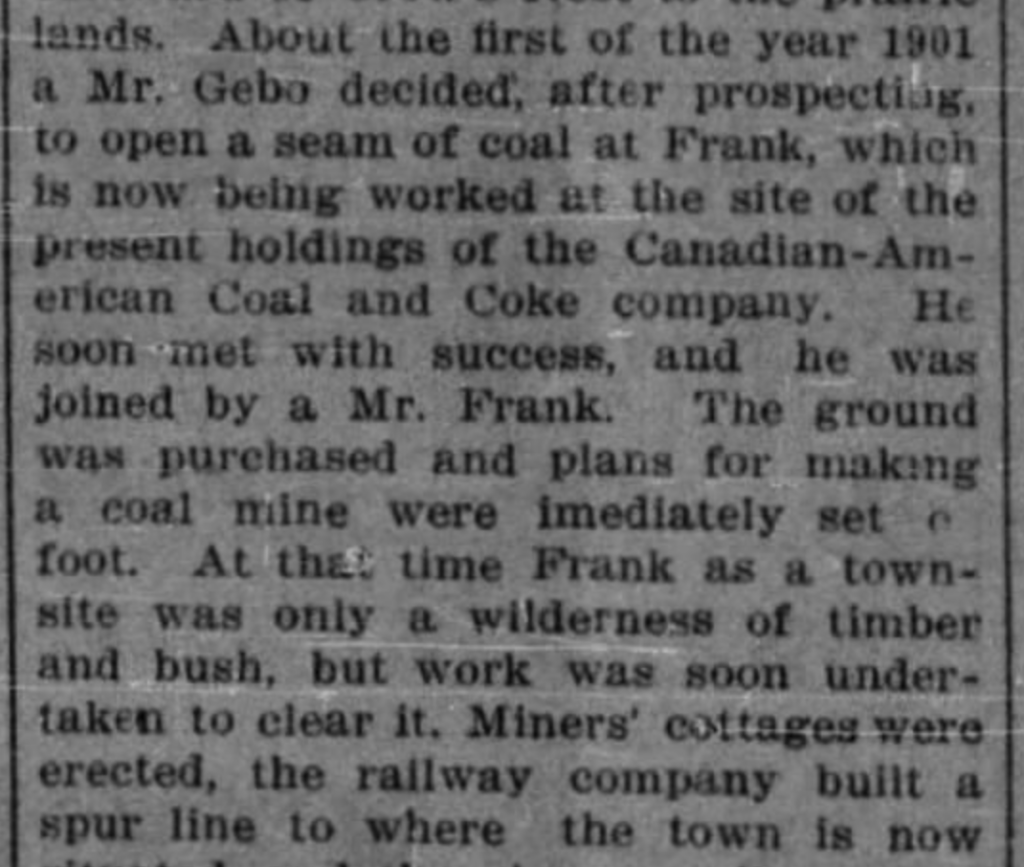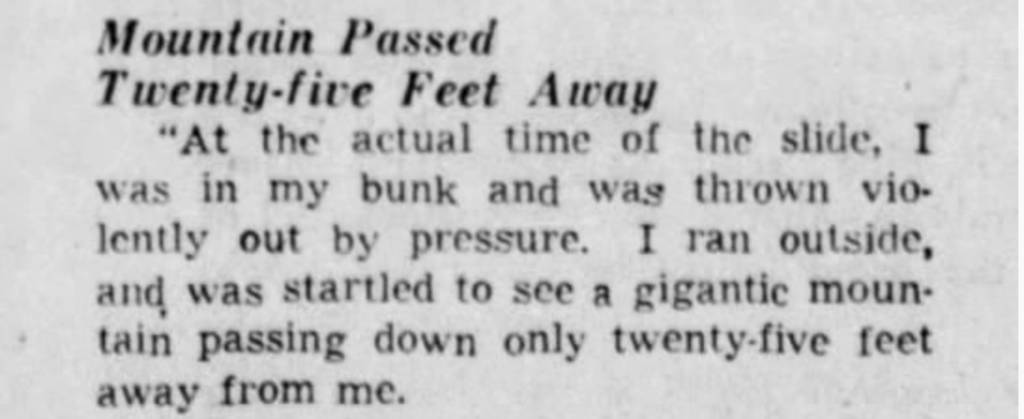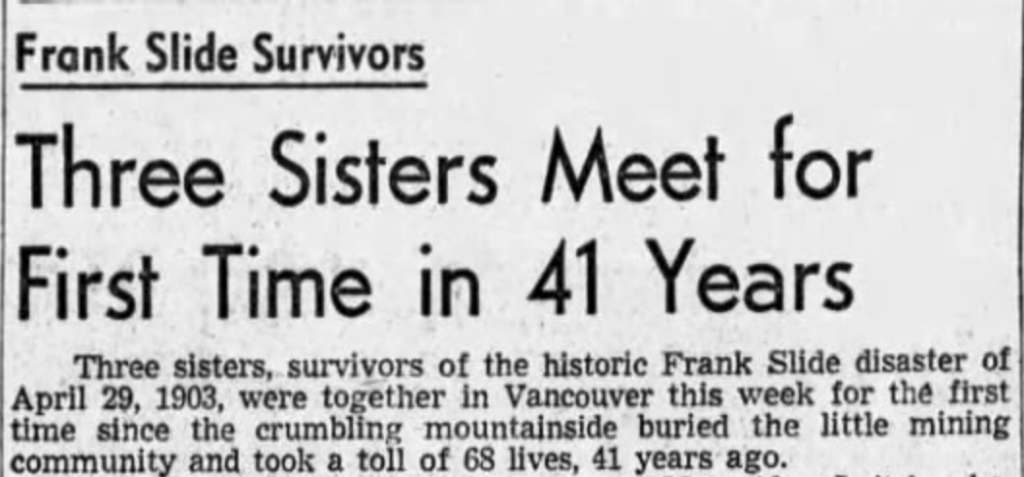In the pre-dawn hours of April 29, 1903, a huge landslide broke loose from Turtle Mountain in Alberta, Canada. Residents in the town of Frank heard rumbling and wondered if there had been an explosion in a nearby coal mine. Within minutes, approximately 90 million tons of limestone crashed down, entombing more than 90 of the town’s residents under 150 feet of boulders.

Turtle Mountain is located in a picturesque section of Crowsnest Pass in southwest Alberta. In the 1880s, settlers discovered a seam of coal in the area. In 1901, American entrepreneurs Henry Frank and Sam Gebo opened a coal mine, and shortly after the town of Frank became the first incorporated village in the Pass. By 1903, 1000 people lived in Frank and a dozen nearby coal mines were operating.
Coal miners honeycombed tunnels through Turtle Mountain without realizing that they were further weakening the already unstable geological structure of the mountain. Layers of sedimentary rock had been tilted to almost vertical over time and erosion in the lower part of the mountain created a dangerous overhang of rock on top. For millennia, water seeped into cracks in the rock. Repeated freeze-thaw cycles caused the cracks to widen, creating more instability.
When the residents of Frank went to bed the night of April 28, 1903, they had no idea of the power of nature about to be unleashed in their town. At 4:10 a.m. on the morning of April 29th, a loud rumbling awakened them. The sound was reportedly heard by residents living nearly 100 miles away. An avalanche of rock broke free from the mountain and careened down, traveling over 180 miles per hour. It reached the valley floor in just 100 seconds.

George Hie was a miner in Frank and recalled hearing a cracking noise coming from the mine about two weeks before the slide. “The pressure was so great at this place that a six-inch timber was broken,” he said. The morning the Frank Slide broke loose, Hie was sleeping in his bunk. “I was thrown violently out by pressure. I ran outside and was startled to see a gigantic mountain passing down only twenty-five feet away from me.” After the dust settled, Hie saw the corner of a house protruding from the rocks. He heard a cry for help and frantically helped dig out a trapped woman. Her two children died. Later, Hie found the bodies of two boys about 200 feet from their cabin. “They were clad in pajamas. Their bodies never had a mark on them.” Hie wondered if they had time to run or if the force of the blast carried them there.

Three young girls were among the survivors, dug out alive hours after the slide. Sadly, their parents and brothers perished in the disaster. The three sisters were adopted by separate families and reunited for the first time in 41 years in 1944. The bodies of most of those killed remain buried under tons of rock in Frank, and the scar from the rockslide serves as a visible reminder of the tragedy that occurred 117 years ago this month.
If you would like to learn more about the Frank Slide, search Newspapers.com today!


great history clip really enjoyed
The Frank Slide is even more impressive in person. I was fascinated with the area as a child. I was fortunate to see the incredible after math of the “slide” as a child in the late 50’s and early 60’s. According to legend Mountain was called Turtle Mountain by the local First Nations people who believe the mountain was slowly moving and were wary of it. My grandfather hauled rocks to improve the road after the Coal Mine he worked at was shut down by an eleven month strike. I returned to the area with my brother and his grandchildren in 2018. We were still in “ah” of the impact of the Slide even today. I newspaper clips really made the article. It brought back incredible childhood memories.
yes, because of the shifting there are never seen a animal on that mountain, we lived the pass for ten year, some time in the little area known as Hillcrest,right under the slide,children climb there on the rocks. Such beautiful country.
WOW! We were there 27 years ago in 2003. What an awesome and scary sight. All that rock! Very impressive even by today’s standards. We really
enjoyed our time in that area of Canada. Such a beautiful country.
I haven’t been there, but it’s on the bucket list. My grandfather George Gage , who is deceased now, said he was the telegrapher on the train. I have no confirmation of that other than local newspaper clippings; however hus name is not mentioned.
Another WOW! Personal connection to history. My finger typed 27 years, was 17 years.
Now go see Mt. St. Helens. It’s pretty impressive also.
My husband and I were there about 1992, and were awed by the historical displays of this awful calamity. Well worth the trip to view this site, amid some of the most beautiful mountain scenery anywhere.
Another town which disappeared under a landslide was in Utah. Thistle was a company town. I remember going through there, both before and after. The news stories about the road put in by a rancher who got tired of making a long trek for food was quite enjoyable.
My dad told us that his dad was a travelling salesman at the time and had overnighted nearby. After the slide he was one that had walked down the tracks (or road) to the town and had helped retrieve a girl from a house there. I have no evidence other than that recollection passed down. My grandfather’s name was William Crawford Pratt.
Going through this community even today, is amazing. The slide looks fresh and it is hard to even imagine the magnitude of it.
As a child I lived in Vulcan, Alberta The Hotel in Vulcan was moved from Frank and was said to be one of the very few buildings to remain standing, it was almost completely unscathed. It was completely disassembled and reassembled in Vulcan You could see the chips in the glass windows.
It inspired a song by the Canadian band Tanglefoot. Not an actual happening, but set at the Turtle Mountain Crash. https://www.youtube.com/watch?v=3PilPwGSm9E
I know that song, and loved that band!
My wife Bernice was a techie for that band back in the 80’s when they had a leave of absence from teaching and toured Canada. I was fortunate enough to be with then in Ottawa and did a documentary for my Trent University film course. What wonderful times they were.
David Fraser
love getting this kind of stuff in my mailbox regarding Canadian history. thank you for sharing.
I lived in Elk Valley, BC and in order to travel to Lethbridge, AB I had to travel through the slide area along Highway # 3. No trees, no wild flowers, no graffiti is allowed to be spray painted on the rocks so the place looks as stark as when the slide occurred. Many of the descendants of the lost victims live near by in Coleman, Blairmore and surrounding areas. Being only 100 years plus, most memories are still fresh in their lives. There is a museum up the road on the right when travelling HWY # 3 WEST.
Could this event have been the inspiration for Harry Chapin’s song, The Rock?
My family visited Frank Slide several times when I was a child in the 50’s and early 60’s. We were always fascinated by it. We traveled through the area again in 2011. It was amazing how many of the big boulders were gone. I suppose they had been crushed and hauled away for road building material.
It is also interesting to note that there was a railway break man named Sid Choquette. He knew that a passenger train was heading through the area shortly and ran to flag it down and stop it before it crashed into the debris saving several lives.
“Snowing in June:”, by Belle Kovach and Mary Bole, is a 252 page well researched account of the disaster. The authors feature genealogical connections of the miners. The book was published by the Crowsnest Pass Historical Society in 1914.
The society’s address is Box 306, Coleman, Alberta, Canada T0K 0M0
I am pretty sure the Canadian novel The Outlander, by Gil Adamson, is set in Frank and it includes the landslide in its plot. It’s an excellent novel!
Fascinating! Please continue with these kind of emails. If I had doubts about my subscription to Newspapers before, I don’t anymore. This is great history!
Great to read this. Was unaware of the Frank Slide until I heard Ken Yates sing of it a couple years ago.
https://www.youtube.com/watch?v=Rm_SABAekw0
Is there more information regarding the sisters adopted by different families? 41 years seems an awful long time to be separated!
I wonder that they were not doubly scarred, by both the trauma of the landslide and loosing their parents & brother…and then by the long separation from each other.
My family visited the Frank Slide in about 1950. It was so impressive. We lived in Montana at the time. Thank you for reminding us of this event.
I remember stopping in Frank in the mid 1950’s, traveling with my Grandparents. I still have the postcards we bought showing the slide scene. I remember feeling very sad that so many people died and their town was mostly buried.
I had never heard of this horrific disaster and I’m glacd you have highlighted this Canadian incident for all of us to read about.
Gratefully yours,
Susan Perrin, Georgetown, Ontario, Canada